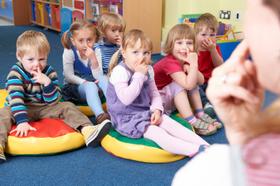Editor's Note: I will disclaim upfront that my eldest daughter went to a Waldorf School in the primary grades. Being creative people, we were impressed with the creative side of the curriculum. Our daughter's two years at a Waldorf school were overall a good experience. ~Rob Kennedy
On the fringes of traditional K-12 education are movements like Montessori, Waldorf, and Reggio Emilia. They offer parents different approaches to early childhood education, and in the case of Waldorf schools, they continue on through high school. Searches on Google and YouTube will yield a lot of information to help you explore the subject of this article, a Waldorf education.
The founder
Austrian philosopher and scientist Rudolf Steiner (1861-1925) established what we now know as the Waldorf or Steiner schools. He opened his first Waldorf school in Stuttgart, Germany Emilia 1919. A hundred years later, there are over 1,200 Waldorf schools worldwide.
According to the Biodynamic Association, "Long before many of his contemporaries, Steiner came to the conclusion that western civilization would gradually bring destruction to itself and the earth if it did not begin to develop an objective understanding of the spiritual world and its interrelationship with the physical world. Steiner's spiritual-scientific methods and insights have given birth to practical holistic innovations in many fields, including education, banking, medicine, psychology, the arts and, not least, agriculture."
This video describes the Waldorf education.
Steiner's philosophy
Rudolf Steiner developed his own, idiosyncratic philosophy which he styled as Anthroposophy. Waldorf Answers defines anthroposophy as follows:
"Anthroposophy is a human-oriented spiritual philosophy that reflects and speaks to the basic deep spiritual questions of humanity, to our basic artistic needs, to the need to relate to the world out of a scientific attitude of mind, and to the need to develop a relation to the world in complete freedom and based on completely individual judgments and decisions."
While this sounds complicated, here's how anthroposophy fits into a Waldorf education. Again, Waldorf Answers states:
"Waldorf or Rudolf Steiner education is based on an anthroposophical view and understanding of the human being, that is, as a being of body, soul and spirit. The education mirrors the basic stages of a child's development from childhood to adulthood, which in general reflects the development of humanity through history from our origin, far back in past times up to the present."
From my perspective as a parent, this is one of the distinctive features of a Waldorf education. I have always felt that my children deserved as an expansive view of history and where they fit in as possible. That's one of several reasons why we sent our daughter to a Waldorf school.
This documentary looks at Rudolf Steiner's philosophy in depth.
Eurhythmy
Rudolf Steiner commented about Eurythmy as follows:
"some little time after the founding of the Waldorf School, it was discovered that Eurythmy can serve as a very important means of education; and we are now in a position to recognise the full significance of Eurythmy from the educational point of view. In the Waldorf School, [The original Waldorf School in Stuttgart of which Steiner was educational director] Eurythmy has been made a compulsory subject both for boys and girls, right through the school, from the lowest to the highest class; and it has become apparent that what is thus brought to the children as visible speech and music is accepted and absorbed by them in just as natural a way as they absorb spoken language or song in their very early years. The child feels his way quite naturally into the movements of Eurythmy. ... " Source: Rudolf Steiner Web
While most of us have never heard of Eurythmy - I certainly hadn't - once you see children expressing themselves in this unique art form, you will understand why it is an integral part of the Waldorf curriculum from the youngest to the highest grade.
The teacher stays with her class.
Another distinctive feature of a Waldorf education is that your child's teacher will stay with her for five to eight years. In other words, your child won't have to become accustomed to a different teacher each year as she progresses through the various grades. It's like parenting. Children don't get a new parent every year, now do they? Of course not! So, this approach creates stability and also allows the teacher to more effectively track your child's progress.
Waldorf Education puts it succinctly:
"A Waldorf teacher typically remains with the same class for five to eight years. In this way, the teacher is better able to assess each individual’s development, needs, and learning style—and the children, feeling secure in this long-term relationship, are more comfortable in their learning environment."
Using computers
Waldorf's approach to technology is straightforward. Computers, tablets, smartphones, and all the other trappings of our 21st-century life are not appropriate for children in the primary grades. Why? Because both Waldorf and Montessori place a very heavy emphasis on developing a child's imagination and creativity. Passive entertainment such as a child experiences while playing a game or watching a video online does little to develop the imagination.
Again, Waldorf Education explains:
"Waldorf teachers appreciate that technology must assume a role in education, but at the appropriate developmental stage, when a young person has reached the intellectual maturity to reason abstractly and process concretely on his or her own, ?which is at around the age of 14. Society might challenge this principle, as many young children are well able to complete sophisticated tasks on a computer; the Waldorf perspective is that computer exposure should not be based on capability but on developmental appropriateness. While many applaud adult-like thinking in young children, we observe that a child’s natural, instinctive, creative and curious way of relating to the world may be repressed when technology is introduced into learning environments at an early age. ~ Excerpt from NYTimes Opinion, 5/2014, Author, Beverly Amico"
Waldorf schools cover the K-12 grades. And they do so with a strong sense of community. The approach is gentle and child-centered. I remember being very impressed that my daughter had no textbooks. Instead, she and her classmates developed their own textbooks as they progressed through their curriculum. Learning was not by rote. It was accomplished by doing, by exploring, and by understanding how the various segments of the lesson fit together.
I encourage you to use Private School Review to find and investigate a Waldorf school near you. It just might be what you are looking for.
Questions? Contact us on Facebook. @privateschoolreview






















